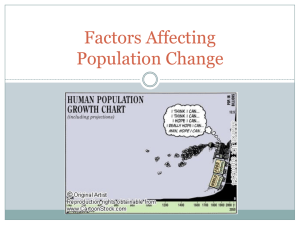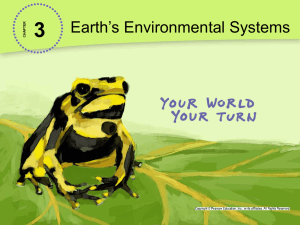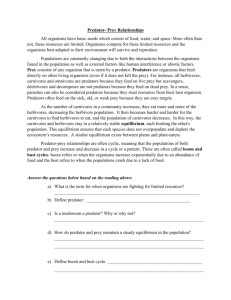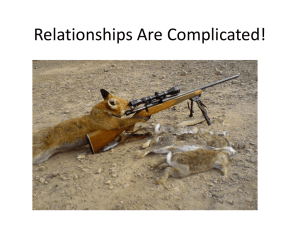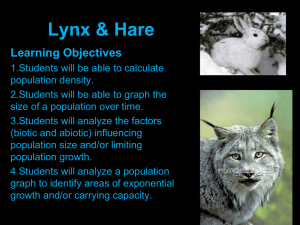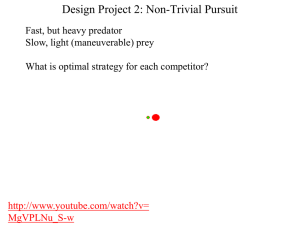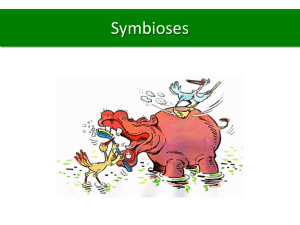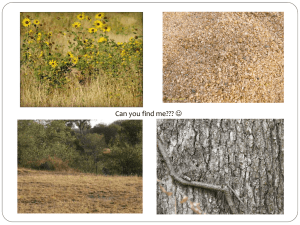populations and sustainability
advertisement
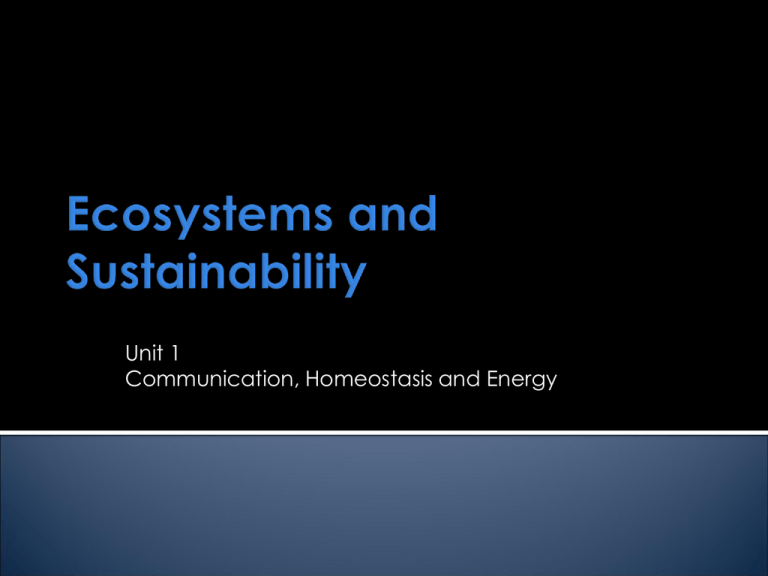
Unit 1 Communication, Homeostasis and Energy Module 3: Ecosystems and Sustainability Explain the significance of limiting factors in determining the final size of a population. Explain the meaning of the term carrying capacity. A group of organisms of the same species, which live in the same place, at the same time and can interbreed with one another. Sigmoid growth curves Populations tend to increase until reaching the maximum number that can live in that habitat. Limiting factor Factor which stops a population from increasing in size. In wild populations, different factors may effect population growth at different times and in different ways Suggest the limiting factors for a population of song thrushes in the gardens of a small town. Limited supply of slugs, snails and invertebrates (food) Nesting sites Predators parasites Limiting factors also include the abiotic factors Water Light Oxygen Shelter temperature Abiotic - Non living factors Biotic – living factors Temperature Competition Light intensity Predation Soil pH disease Availability of water Availability of minerals Density dependent factors Effect increases as population density increases Population level off, then decrease Example - availability of food Density independent factors Effect independent of the size of the population Example – forest fire The maximum population size that can be maintained by an area over a period of time. In the wild it is unlikely that a population will enter a decline or death phase A population will fluctuate up and down about the carrying capacity Describe predator–prey relationships and their possible effects on the population sizes of both the predator and the prey. Patterns of predator prey interaction Stable coexistence Cyclical variations Erratic swings Extinction of prey species Important factors to consider Carrying capacity of the habitat Reproduction rate of prey Reproduction rate of predator Degree of flexibility of predator to switch prey Evidence suggests that The size of the predator population is influenced by the size of the prey population And vice versa Predatory mite and its prey were introduced to a controlled environment The populations of both mites oscillate The population of the prey rises followed by the population of the predator Rise in population of predator follows that of the prey Prey population limited by the rise in predators Reduction in food supply limits the predator population Prey population begins to increase again In the wild, it is more likely that the predator will have more than one food source. Although predatory-prey interactions are thought to be one of the main factors affecting the populations of lynxes and snowshoe hares in Northern Canada. Convert the information in the table into a graph to illustrate any patterns that may exist. Label and number the axes clearly Decide how to represent the populations of hare and lynx on the same graph. year Population of hare (thousands) Population of Lynx (thousands) 1845 12 22 1850 10 39 1855 63 6 1860 72 21 1865 139 3 1870 3 60 1875 62 4 1880 83 35 1885 120 63 1890 12 10 1895 70 40 1900 10 5 1905 68 43 1910 20 2 Describe and explain the patterns shown by the graph By removing prey who are strong competitors, weaker competitors can survive Reduce effect of competitive exclusion The ecosystem benefits from Increasing species diversity Increasing stability The ability to adapt to environmental change Examples where removing predators has collapsed an ecosystem Otters and the sea kelp forests Predator-prey populations Look at the two graphs on the worksheet Answer the accompanying questions Predatory mite vs Prey 1. Predator is the secondary consumer, prey mite is the primary consumer 2. Energy lost as transferred through trophic levels ▪ ▪ Less energy to support 2o consumers As biomass of each individual is the same, the number of secondary consumers will be smaller than the number of primary consumers Lynx vs. Snowshoe hare Lynx furs oscillated in 7-8 year cycles, never rising above 6000 furs trapped, but in some years almost none were trapped Lynx and hare populations oscillate on the same time scale 1. 2. Which fits the predator prey theory as lynx data shadows that of the snow shoe hare after about 2 years. Other factors Parasites Inconsistent trapping No records of other possible factors Explain, with examples, the terms interspecific and intraspecific competition. Interspecific interactions Between individuals of different species Intraspecific interactions Between individuals of the same species Which type of interaction is more intense, interspecific or intraspecific? Why? Individuals that are best adapted will survive to reproduce Slows down population growth and population enters stationary phase Keeps population stable Decrease in population size, competition reduces, population size increase Vice versa intense Occurs when two niches overlap Affects population size and distribution of a species in an ecosystem The sum of An organism’s adaptations The resources it needs The lifestyle to which it is fitted Paramecium aurelia and P. caudatum Experiments When cultured together Paramecium aurelia has a competitive advantage over P. caudatum for gaining food. The more overlap between two species’ niches would result in more intense competition Competitive exclusion principle When grown together, there was competition for food with P. aurelia obtaining food more effectively than P. caudatum, which died out. Changes in population size of two species of flour beetle, Tribolium confusum and Tribolium castaneum, competing for food and space in a container of wholemeal flour. Several factors work together to influence population size and distribution Example – distribution of two species of barnacle. Chthamalus stellatus Dessication at the top of its range Better at coping with temperature fluctuations and exposure to dry air. Competition with Balanus at the bottom of its range. Balanus balanoides Dessication and competition with Chthamalus at the top of its range Faster growing, so wins the competition for limited space on the rocks in the middle of its range Predation by Nucellus at the bottom of its range and competition with seaweed for space. Competition How much can you remember? Complete the worksheet, commenting on interspecific competition and interacting factors Past paper exam questions Competition ▪ 2804 Jan 05 question 4 Populations and competition ▪ 2804 Jun 06 question 4 Distinguish between the terms conservation and preservation. Discuss the economic, social and ethical reasons for conservation of biological resources. Biodiversity The range of habitats, communities and species that are present in an area, and the genetic variation that exists within each species. Conservation Active management of habitats in order to maintain or increase biodiversity Preservation Protects species or habitats e.g. by creating a nature reserve Management of human use of the biosphere so that it may yield the greatest sustainable benefit to present generations while maintaining it’s potential to meet the needs and aspirations of future generations. World conservation strategy Ecosystems are not static, they are dynamic i.e. they change over time Preserving an area without active management, may not be the best thing for that area. Conservation is the protection of ecosystems, habitats and species These means taking action to halt destruction and extinction Conservation involves Managing areas of land Taking steps to encourage new habitats Removing animals to captivity Growing plants in cultivation The main reasons given for conserving species are Economic Ethical social Natural ecosystems provide services Examples ▪ Regulation of atmosphere and climate ▪ Formation and fertilisation of soil ▪ Recycling of nutrients ▪ Growth of timber, food and fuel Ecosystems also provide goods such as wood and fish for free. Tourism Species become extinct as a result of human action Humans have a responsibility to maintain species, ecosystems and habitats for future generations All organisms have a right to survive and live in the way to which they have become adapted. People enjoy visiting wild places Observing wildlife ▪ The large animals are sustained by an interdependent web which includes a huge number of species Wellbeing – physical, intellectual and emotional health Explain how the management of an ecosystem can provide resources in a sustainable way, with reference to timber production in a temperate country. Removing timber from a forest or woodland in a manner that allows similar amounts to be removed year after year. Maintaining the forest ecosystem Allowing all the different habitats and species to survive When a deciduous tree is cut it regrows from its base The new growth consists of several stems Rotational coppicing Coppice with standards Clear felling can destroy habitats Reduce soil mineral levels Increase soil erosion Increase flooding Increasing biodiversity Leave each section of woodland for 50- 100 years Selective felling where only the largest most valuable trees are felled. Any tree harvested is replaced by another Local people benefit from the forest. Matching tree species to climate, topography and soil type Planting trees the best distance apart. Controlling pests and pathogens Using every part of each tree felled Maintaining a sustainable forest ecosystem Gather information on biodiversity and wildlife Consider transport links and markets Formulate ecological and business plans Select appropriate species to grow Measurement of forest growth and structure Application of ecologically sensitive systems ▪ Clear felling vs. selective felling vs. strip felling Recreational use of forests by the public Use of broad-leaved deciduous species Explain that conservation is a dynamic process involving management and reclamation. Ecosystems are dynamic and everchanging Heathland if abandoned would gradually revert to woodland again (natural climax community) with the loss of important species Conservation is an on-going process, its demands change as the ecosystem itself changes. This requires constant monitoring of the habitat and biodiversity. Management strategies include: Raising carrying capacity Encourage dispersion of individuals e.g. wildlife corridors Control predators Vaccinate against disease Preserve habitats ▪ Prevent pollution ▪ Intervene to restrict succession Designated as a Site of Special Scientific Interest “key species” were identified for consideration when management plans for conservation areas are drawn up Threats identified Disturbance to animals caused by humans Pollution leading to nutrient enrichment Drop in groundwater levels To maintain and increase biodiversity To restore and reclaim former heathland Maintain a high water table Allow cattle to graze Removal of trees Outline, with examples, the effects of human activities on the animal and plant populations in the Galapagos Islands Small group of Islands lying on the equator to the west of Ecuador There are about 24 Islands All islands are the tips of volcanoes that erupted under the sea millions of years ago The unique ecosystems, communities and endemic species are under threat Population growth Over-fishing e.g. sea cucumber Tourism Exotic species ▪ Feral dogs eat tortoise eggs ▪ Cats hunt lava lizard and young iguanas ▪ goats Quarantine system All boats and tourists that arrive are searched for exotic species Use natural predators to control pest populations Culling Isabella had a huge feral goat population Plan To destroy the entire goat population ▪ “Judas Goats” were released with radio collars ▪ Specially trained hunters with high-performance weapons used information from aerial surveys and GPS. ▪ Goats were dispatched humanely Success Story By 2006 all goats had been destroyed Increases in growth of tree ferns and vegetation Tortoise population now expected to thrive 36% of coastal areas are designated as “no-take” areas No extraction of resources Communities are left undisturbed On the Island, Espanola, there were only 14 giant tortoises left These were all captured and kept for captive breeding Over 100 offspring have now been returned to the Island Finding a balance between environmental, economic and social concerns are essential for conservation to be successful “Lonesome George” The last remaining Pinta Tortoise

